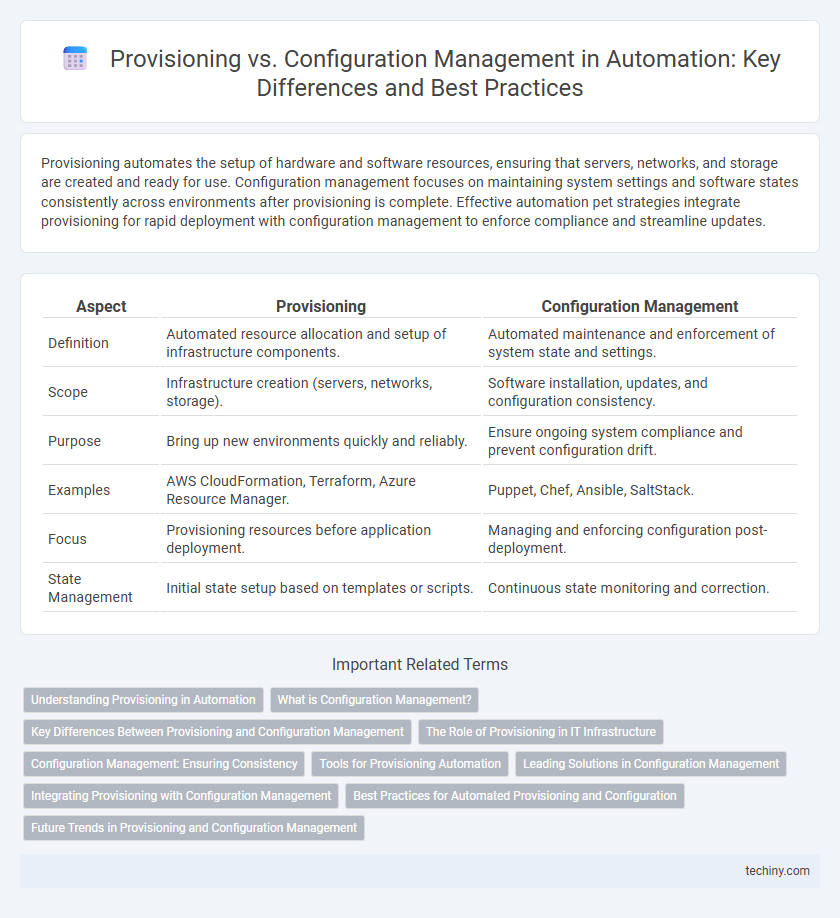Provisioning automates the setup of hardware and software resources, ensuring that servers, networks, and storage are created and ready for use. Configuration management focuses on maintaining system settings and software states consistently across environments after provisioning is complete. Effective automation pet strategies integrate provisioning for rapid deployment with configuration management to enforce compliance and streamline updates.
Table of Comparison
| Aspect | Provisioning | Configuration Management |
|---|---|---|
| Definition | Automated resource allocation and setup of infrastructure components. | Automated maintenance and enforcement of system state and settings. |
| Scope | Infrastructure creation (servers, networks, storage). | Software installation, updates, and configuration consistency. |
| Purpose | Bring up new environments quickly and reliably. | Ensure ongoing system compliance and prevent configuration drift. |
| Examples | AWS CloudFormation, Terraform, Azure Resource Manager. | Puppet, Chef, Ansible, SaltStack. |
| Focus | Provisioning resources before application deployment. | Managing and enforcing configuration post-deployment. |
| State Management | Initial state setup based on templates or scripts. | Continuous state monitoring and correction. |
Understanding Provisioning in Automation
Provisioning in automation involves the process of setting up and allocating resources such as servers, storage, and network components to create an operational environment. It focuses on deploying infrastructure quickly and consistently, enabling scalable and repeatable infrastructure setup. Efficient provisioning reduces manual intervention, accelerates development cycles, and supports continuous integration and delivery practices.
What is Configuration Management?
Configuration Management is the process of systematically handling changes to software, hardware, and system settings to maintain consistency and control across an IT environment. It involves tracking, managing, and automating the deployment of configurations to ensure systems remain in a desired state. Tools like Ansible, Puppet, and Chef are commonly used to implement configuration management by enforcing standardized settings and reducing configuration drift.
Key Differences Between Provisioning and Configuration Management
Provisioning automates the setup and deployment of infrastructure resources, such as servers and networks, enabling rapid environment creation. Configuration management focuses on maintaining system state and consistency by managing software versions, settings, and dependencies across existing infrastructure. Key differences include provisioning's role in initial resource allocation versus configuration management's continuous enforcement of desired configurations for stability and compliance.
The Role of Provisioning in IT Infrastructure
Provisioning plays a critical role in IT infrastructure by automating the setup and deployment of hardware, software, and network resources essential for system operation. It ensures that servers, storage, and virtual machines are rapidly provisioned with the necessary operating systems and applications, enabling scalable and consistent environments. Provisioning complements configuration management by establishing initial environments that configuration tools then maintain and optimize for performance, security, and compliance.
Configuration Management: Ensuring Consistency
Configuration management ensures consistency by systematically maintaining the desired state of software, hardware, and network resources across all environments. It automates the deployment, updates, and verification processes to prevent configuration drift and reduce errors. Tools like Ansible, Puppet, and Chef enable centralized control, versioning, and compliance enforcement for efficient infrastructure management.
Tools for Provisioning Automation
Provisioning automation tools like Terraform, Ansible, and Puppet enable the rapid deployment of infrastructure by automating the creation of servers, networks, and storage resources. These tools use declarative languages to define infrastructure as code, ensuring consistent and repeatable environments across cloud and on-premises platforms. Integration with cloud providers such as AWS, Azure, and Google Cloud enhances scalability and reduces manual errors during infrastructure provisioning.
Leading Solutions in Configuration Management
Leading solutions in configuration management, such as Ansible, Puppet, and Chef, enable automated deployment, management, and scaling of infrastructure across diverse environments, ensuring consistency and compliance. These tools streamline provisioning by defining system states declaratively, reducing manual errors and speeding up environment setups. Integration with cloud platforms and container orchestration systems like Kubernetes enhances their capability to manage complex, dynamic infrastructures efficiently.
Integrating Provisioning with Configuration Management
Integrating provisioning with configuration management streamlines the deployment process by automating resource allocation and ensuring consistent system settings across environments. This synergy enables rapid scalability, reduces human error, and maintains compliance by automatically applying configuration policies immediately after resource provisioning. Centralized orchestration tools like Ansible, Terraform, and Puppet enhance this integration, allowing infrastructure as code practices to unify setup and configuration workflows efficiently.
Best Practices for Automated Provisioning and Configuration
Automated provisioning and configuration management require distinct yet complementary best practices to ensure scalable and consistent infrastructure deployment. Use infrastructure-as-code (IaC) tools like Terraform for provisioning to define and provision resources declaratively, while configuration management tools like Ansible or Chef manage software and system settings post-provisioning. Implement version control for all automation scripts, enforce idempotency to avoid configuration drift, and integrate automated testing and continuous monitoring to maintain system integrity and compliance throughout the lifecycle.
Future Trends in Provisioning and Configuration Management
Future trends in provisioning and configuration management emphasize greater integration of AI-driven automation to enhance scalability and reduce human error. Cloud-native technologies and edge computing drive dynamic resource allocation, enabling more flexible and responsive infrastructure management. Continuous compliance and security automation are becoming critical, ensuring systems remain robust against evolving threats while maintaining operational efficiency.
Provisioning vs Configuration Management Infographic

 techiny.com
techiny.com